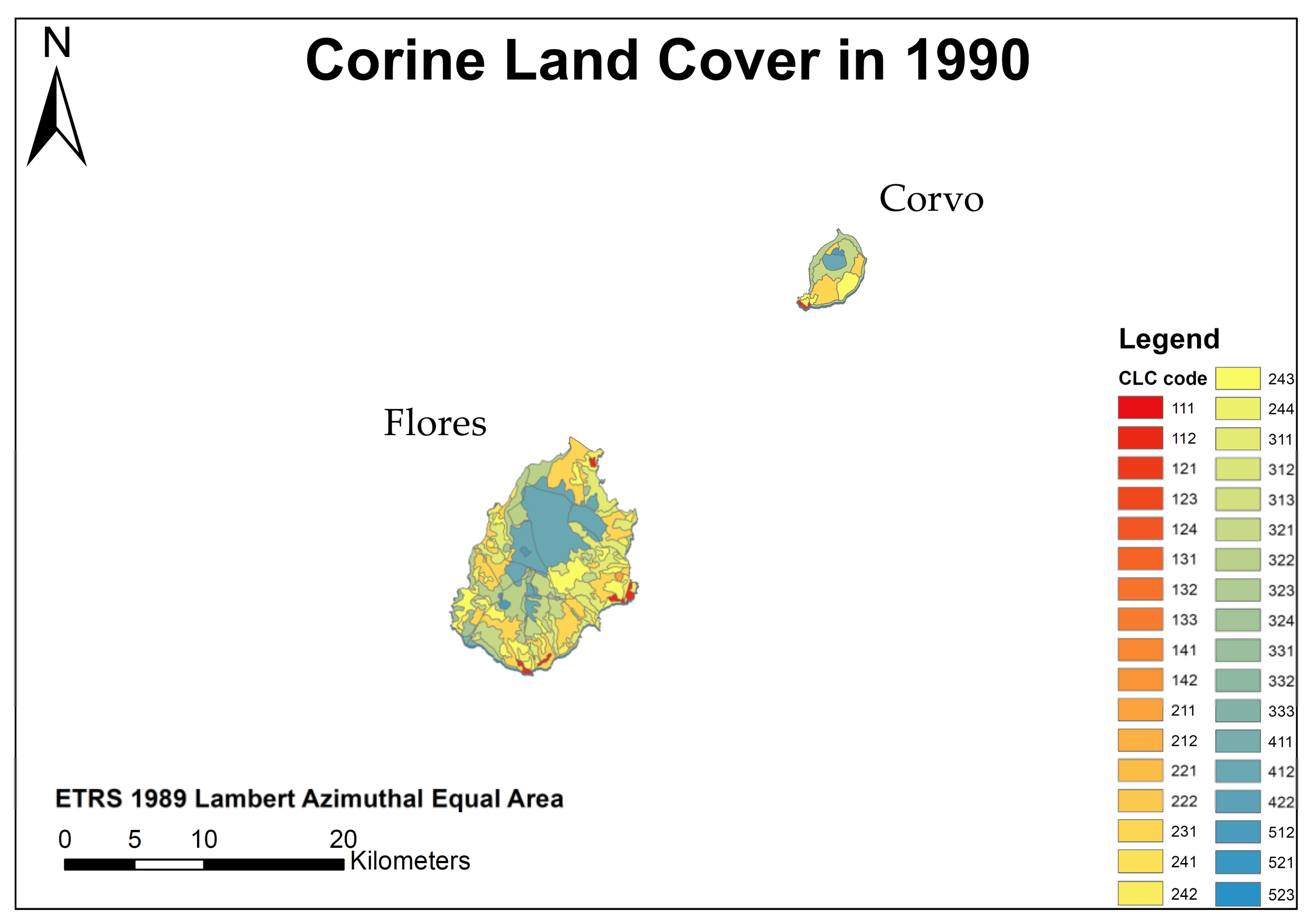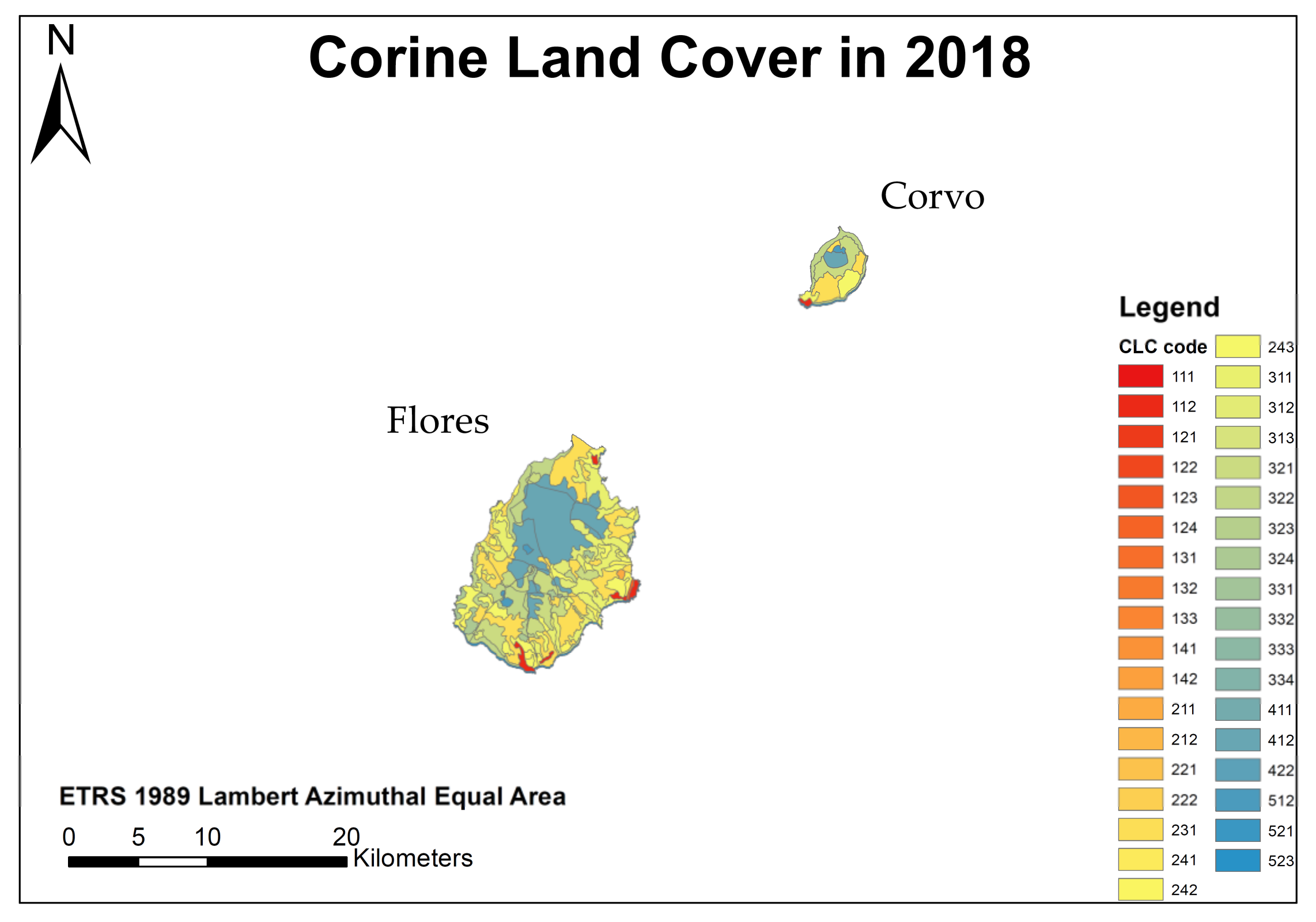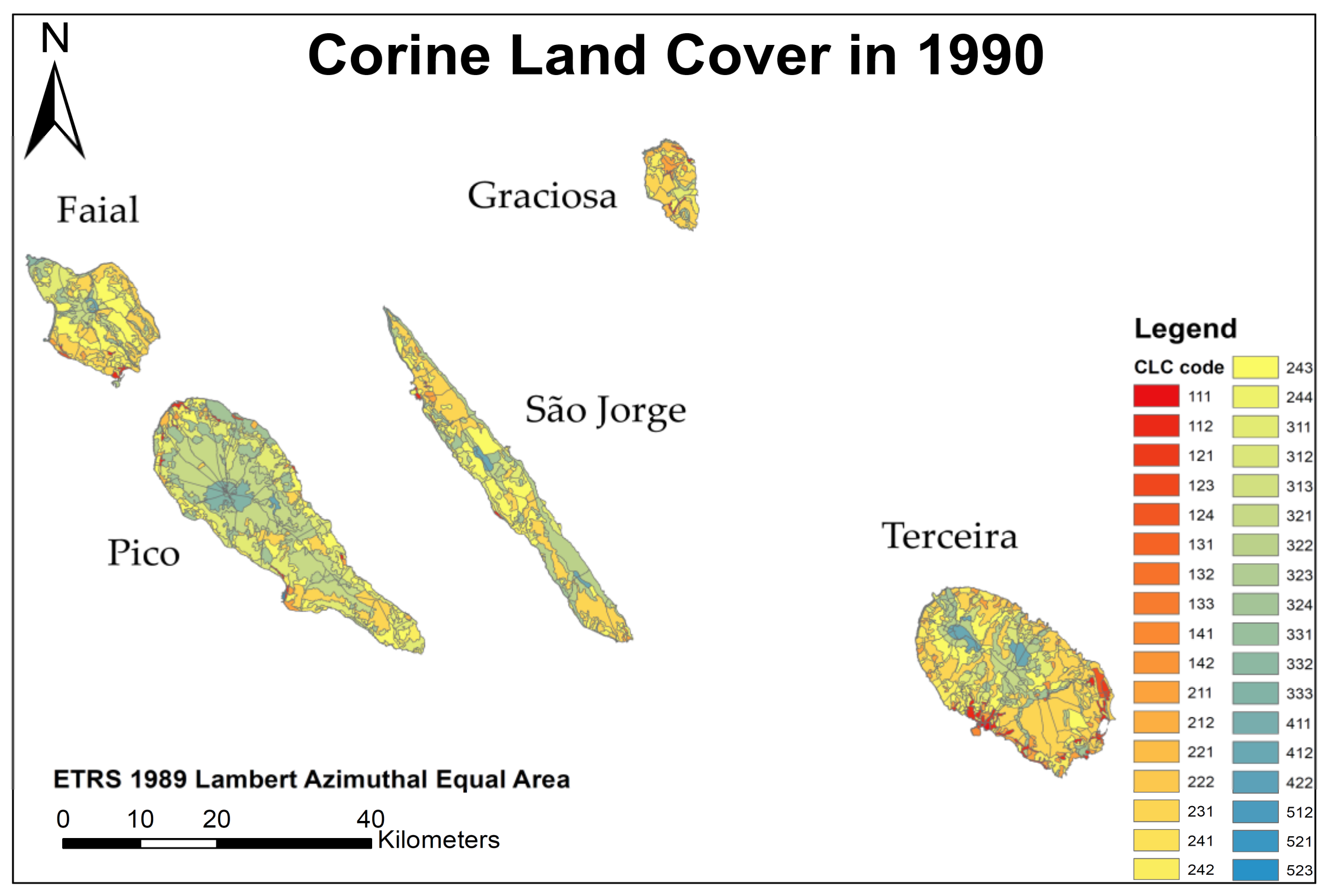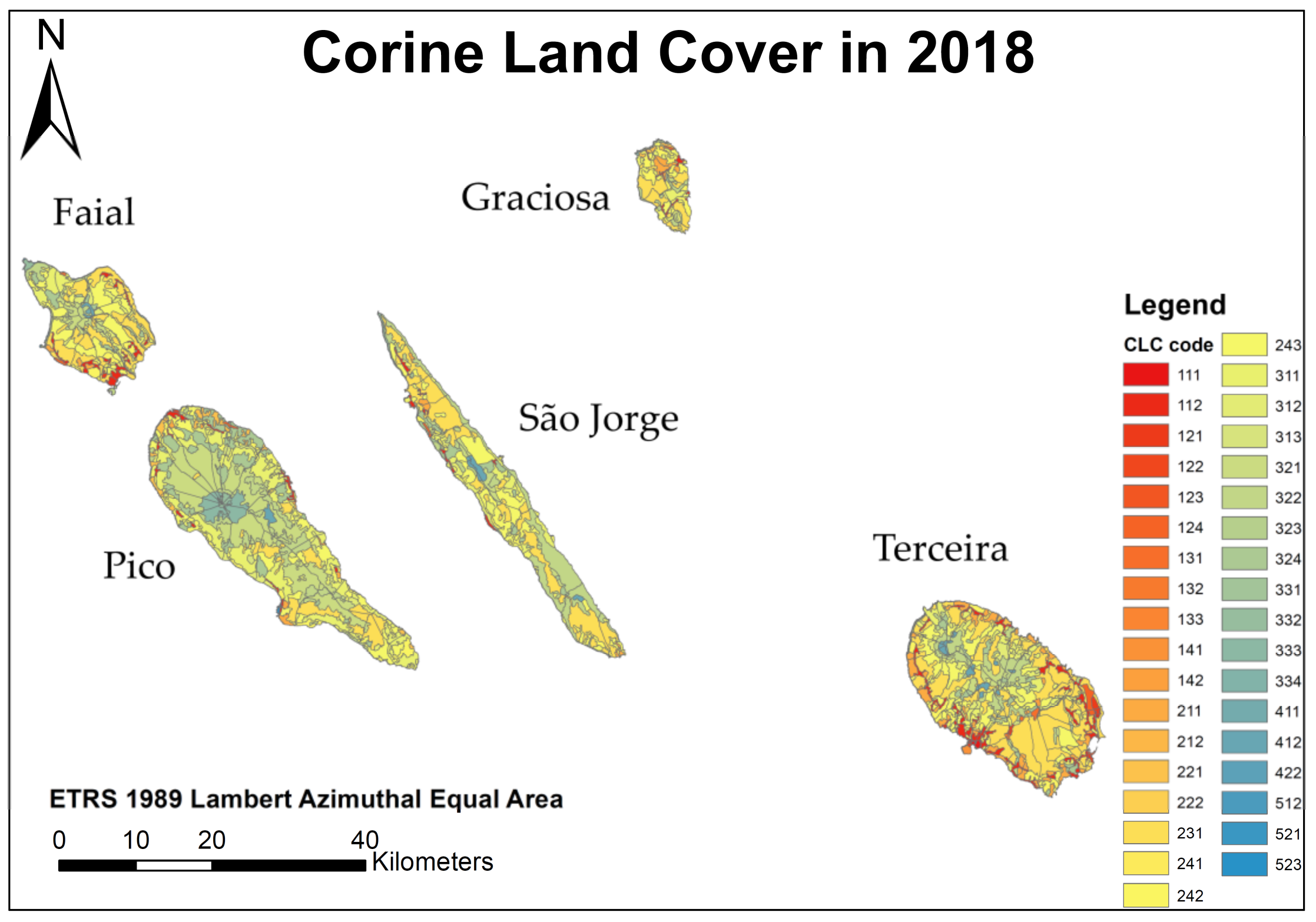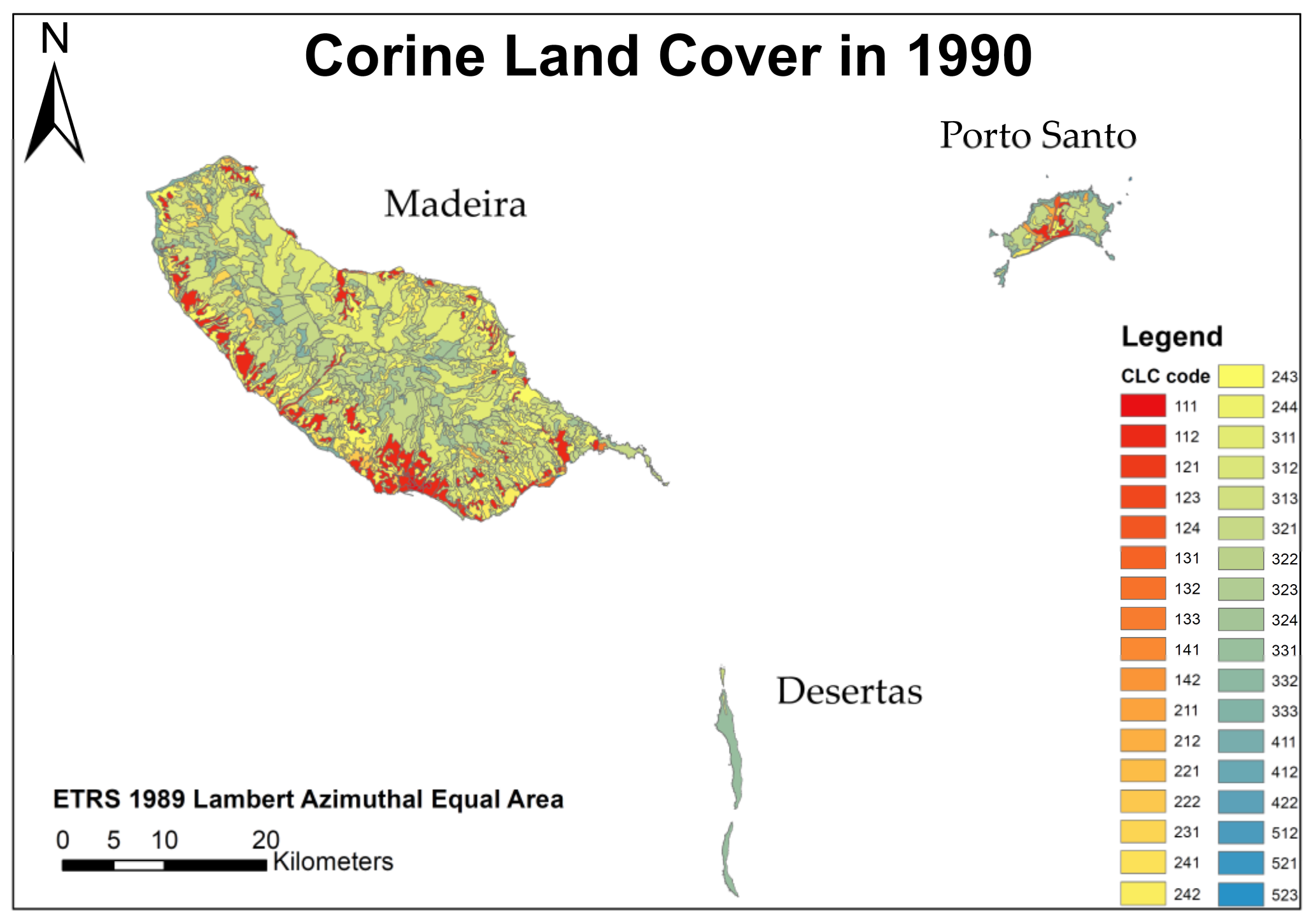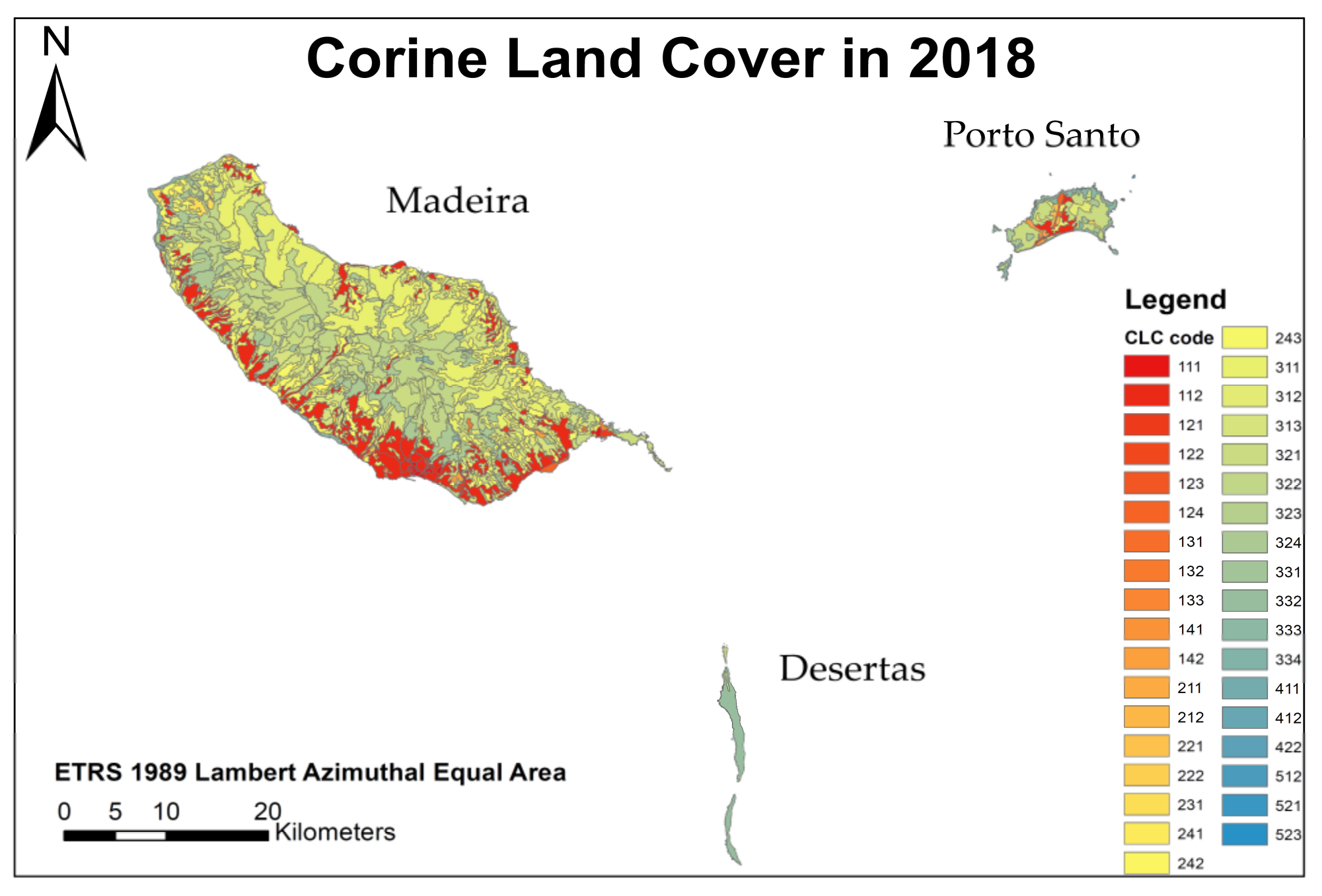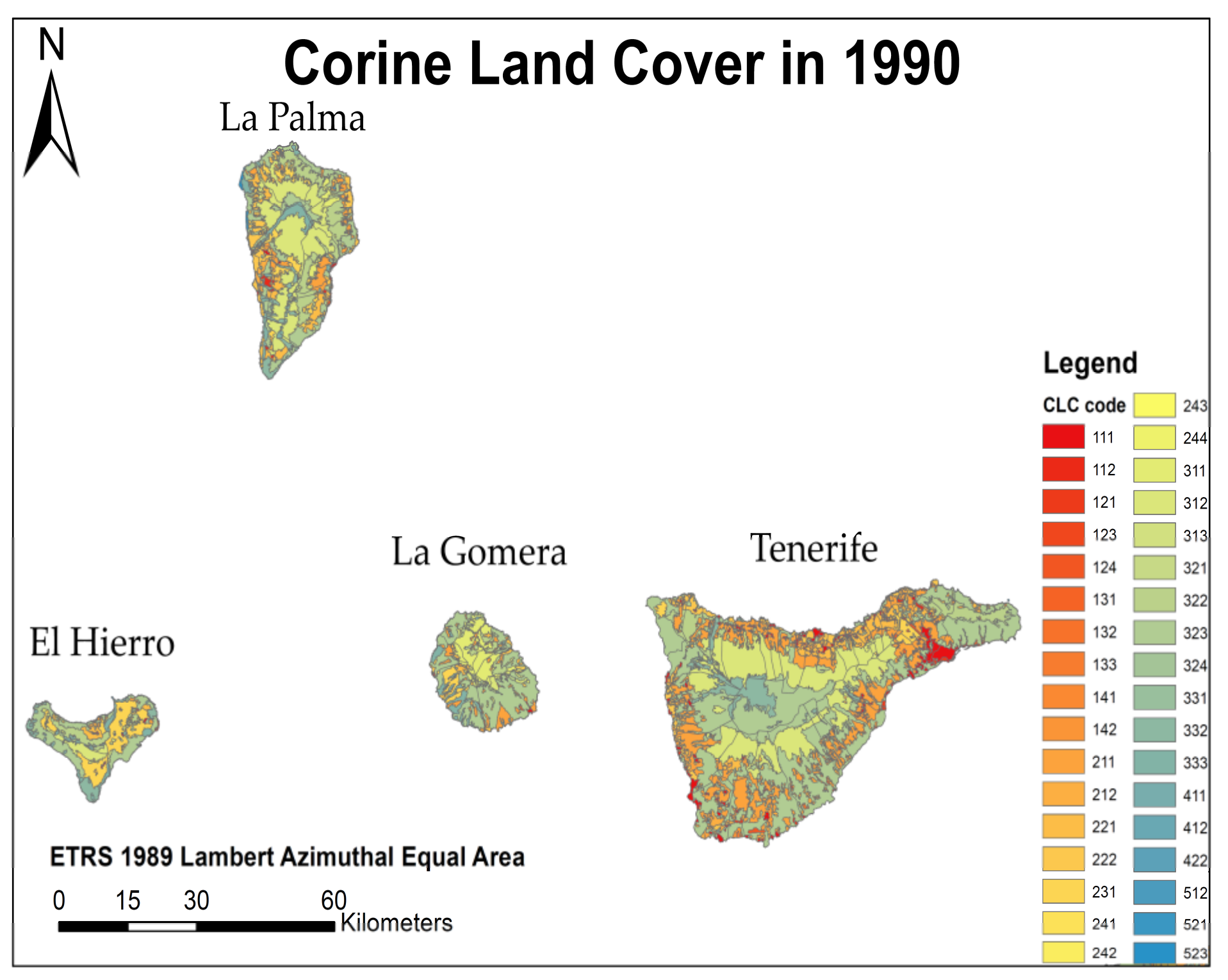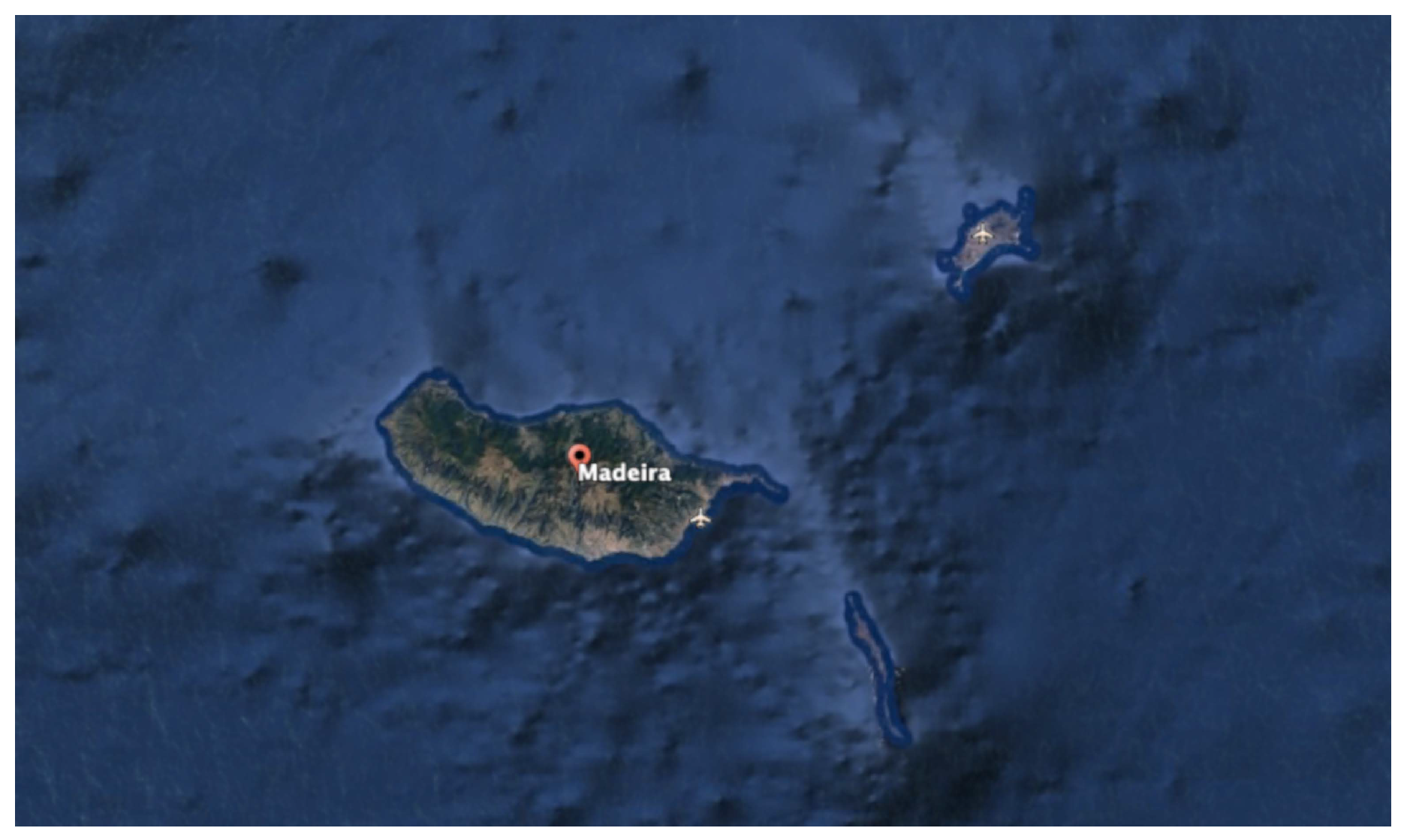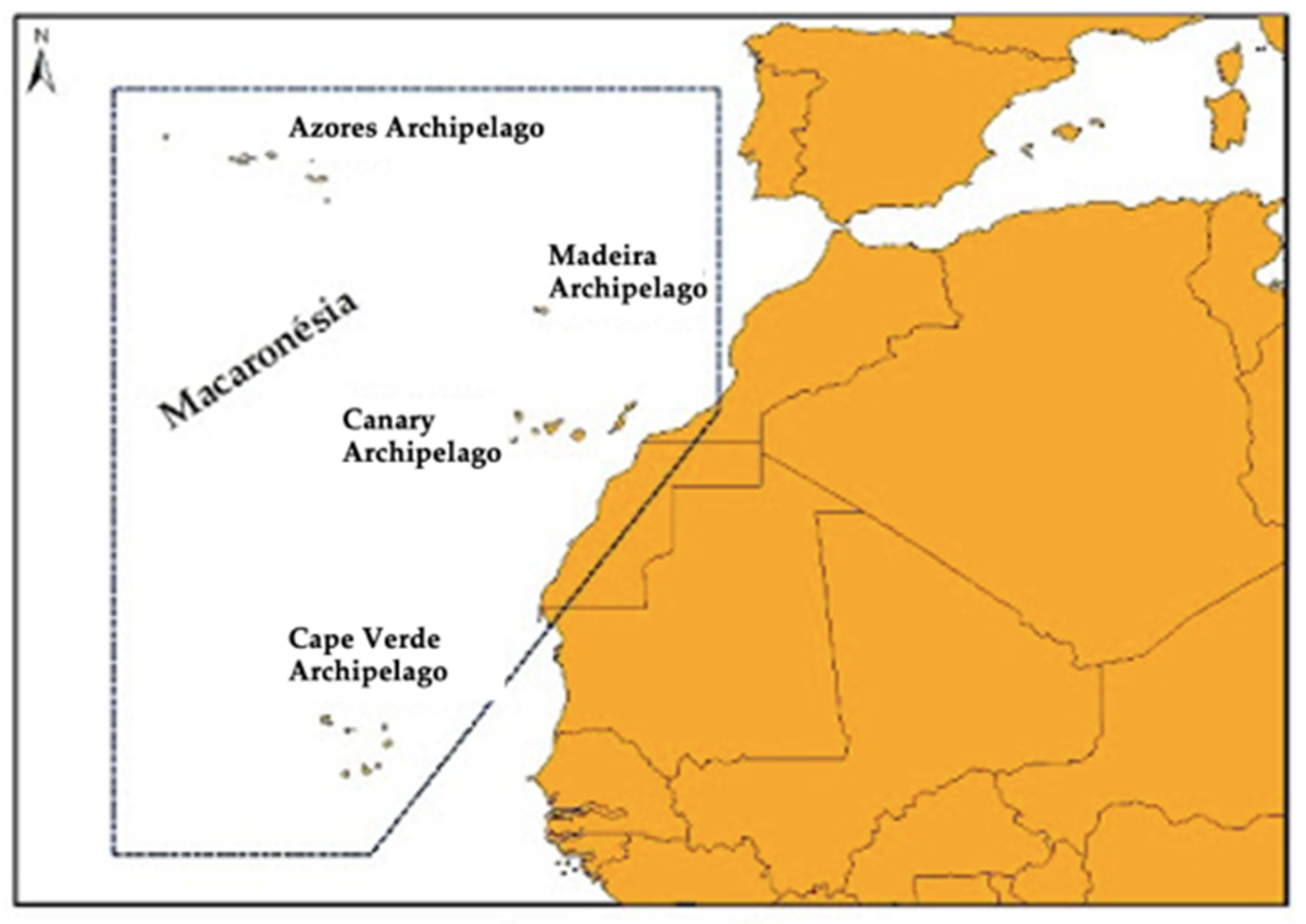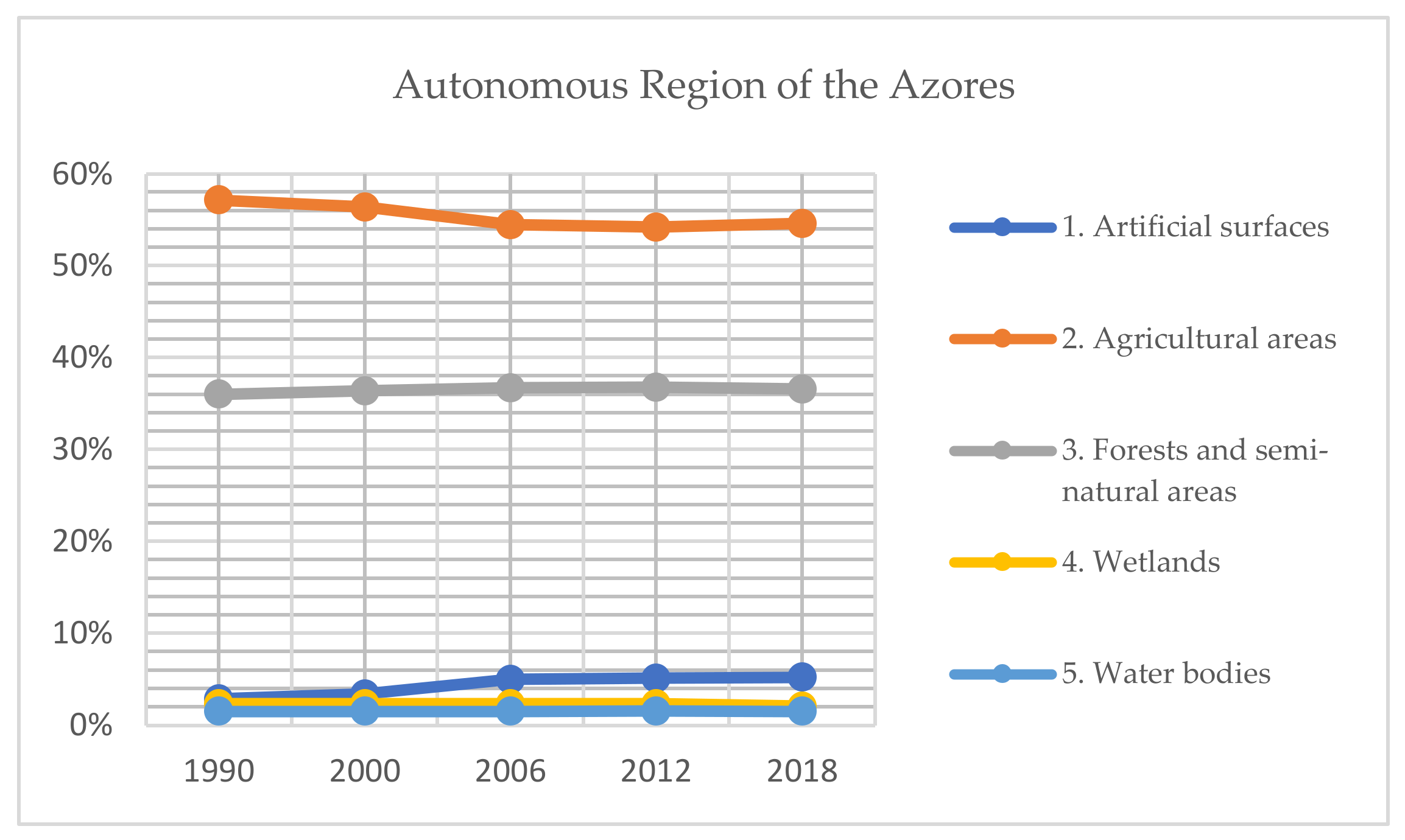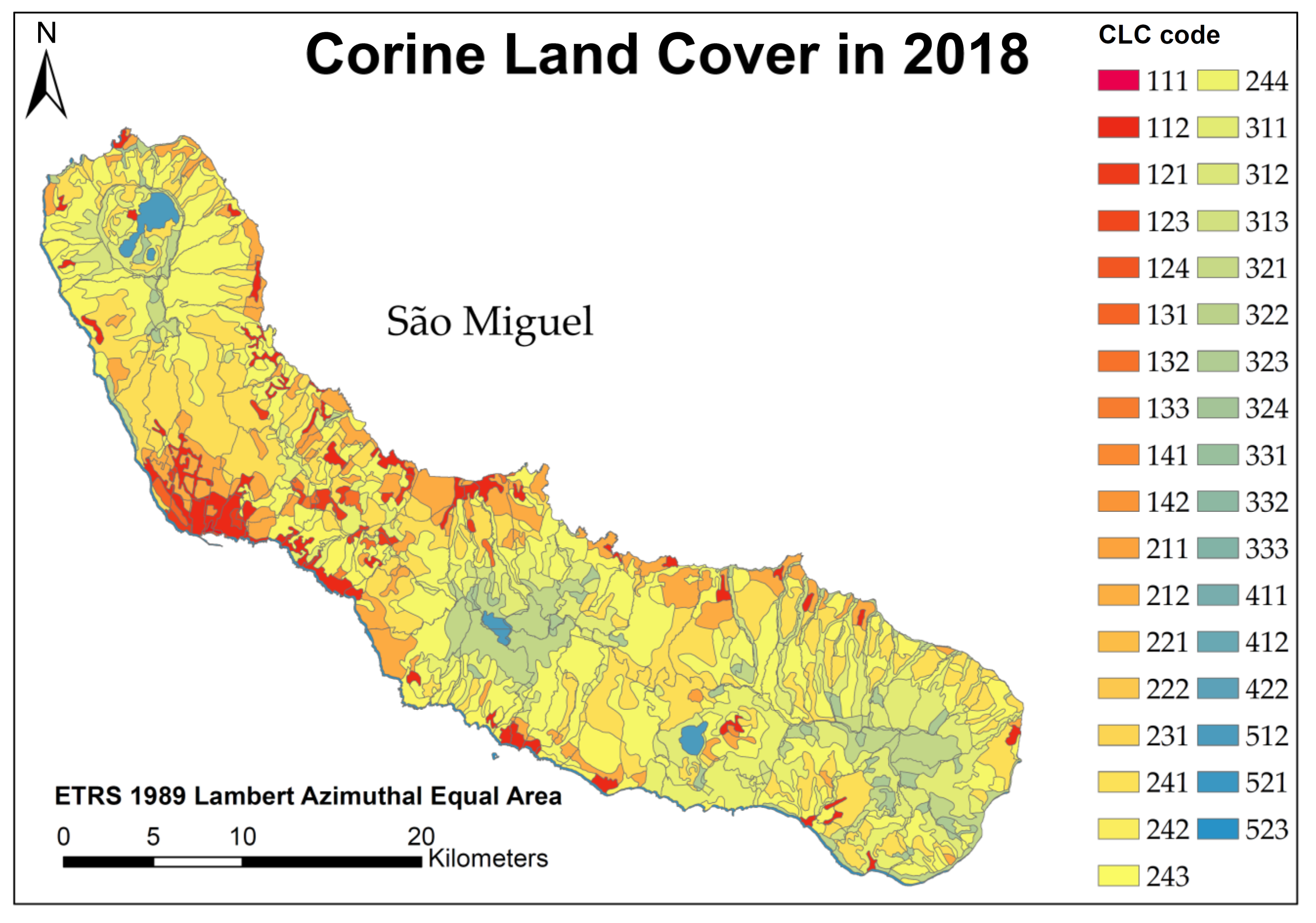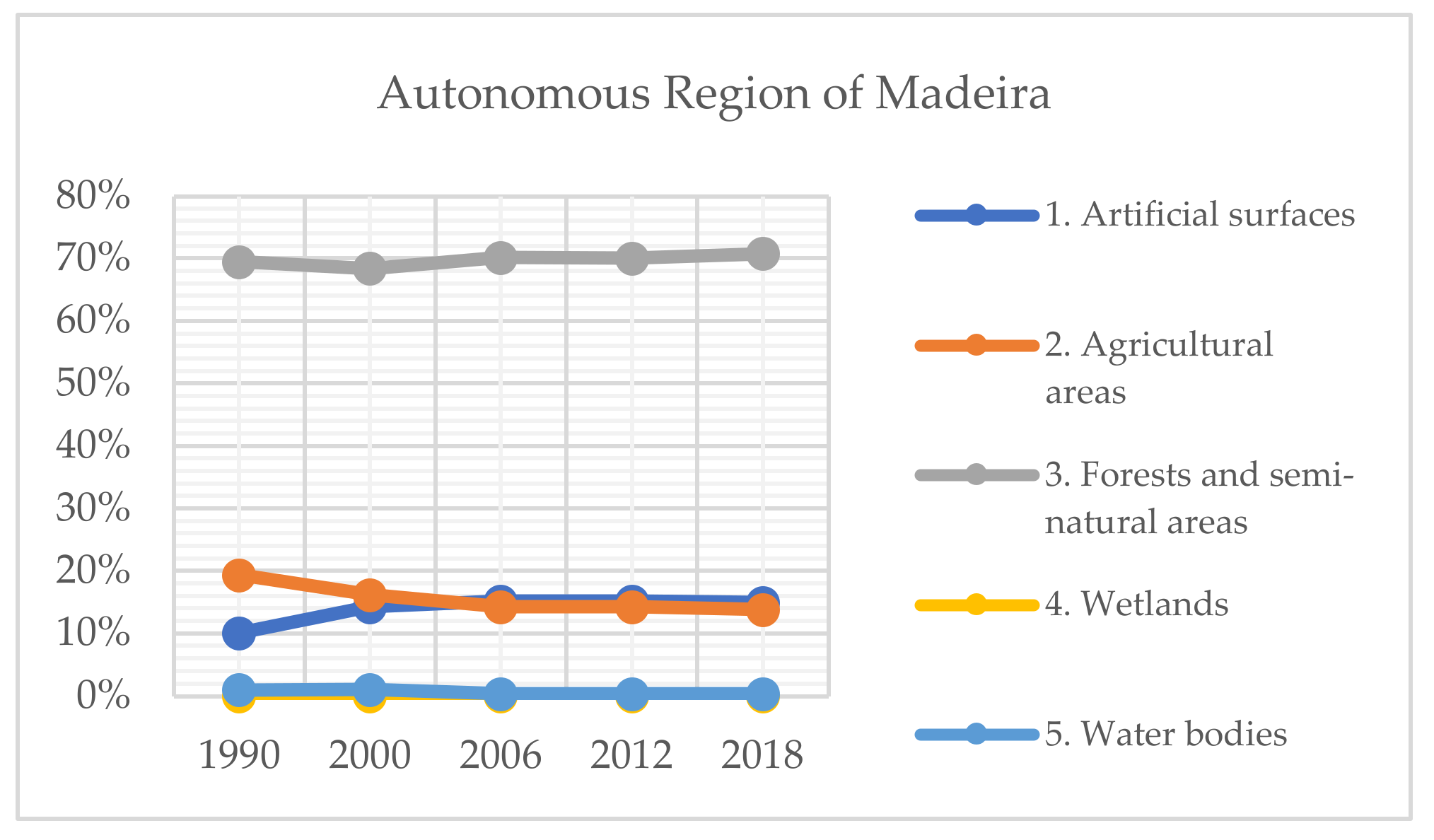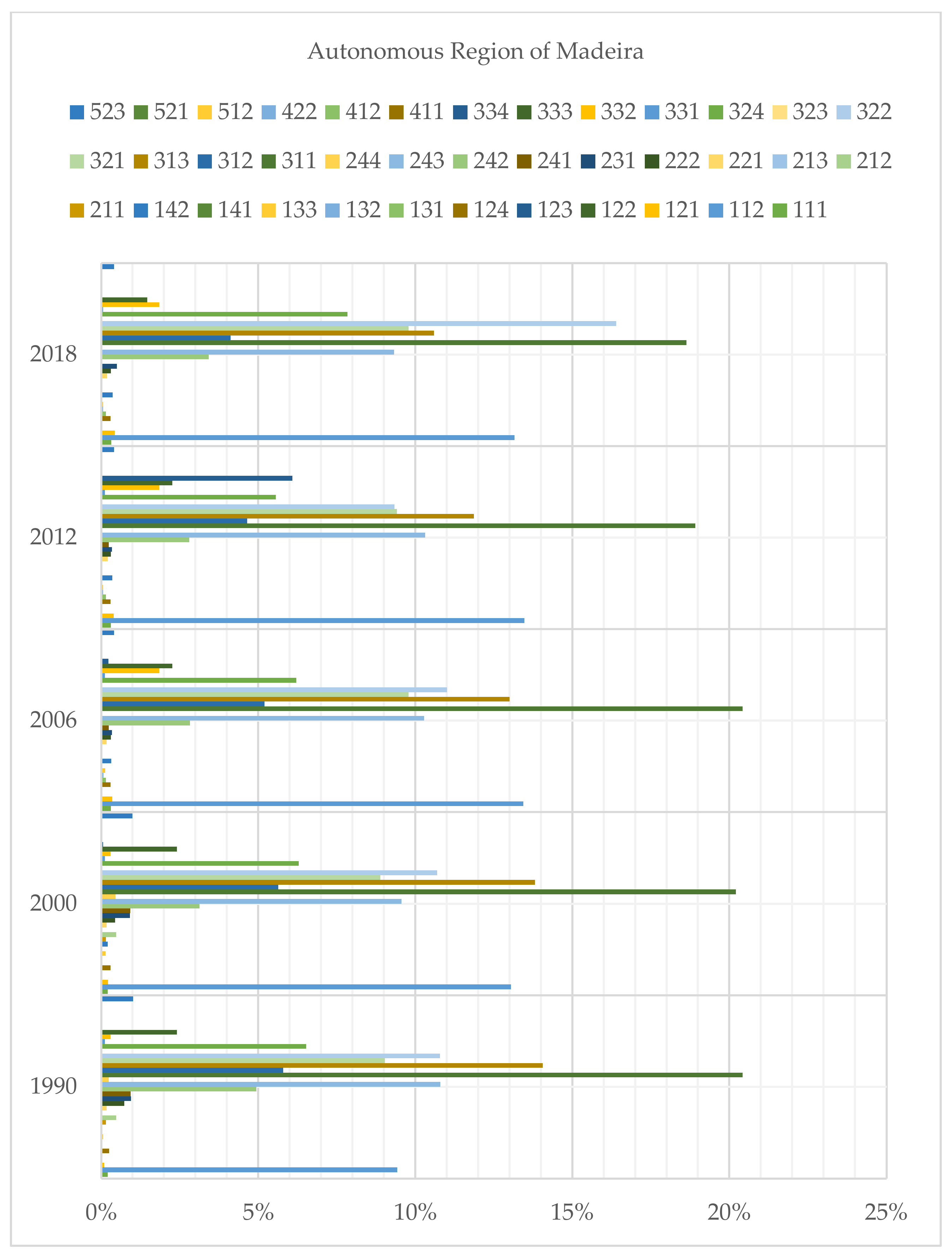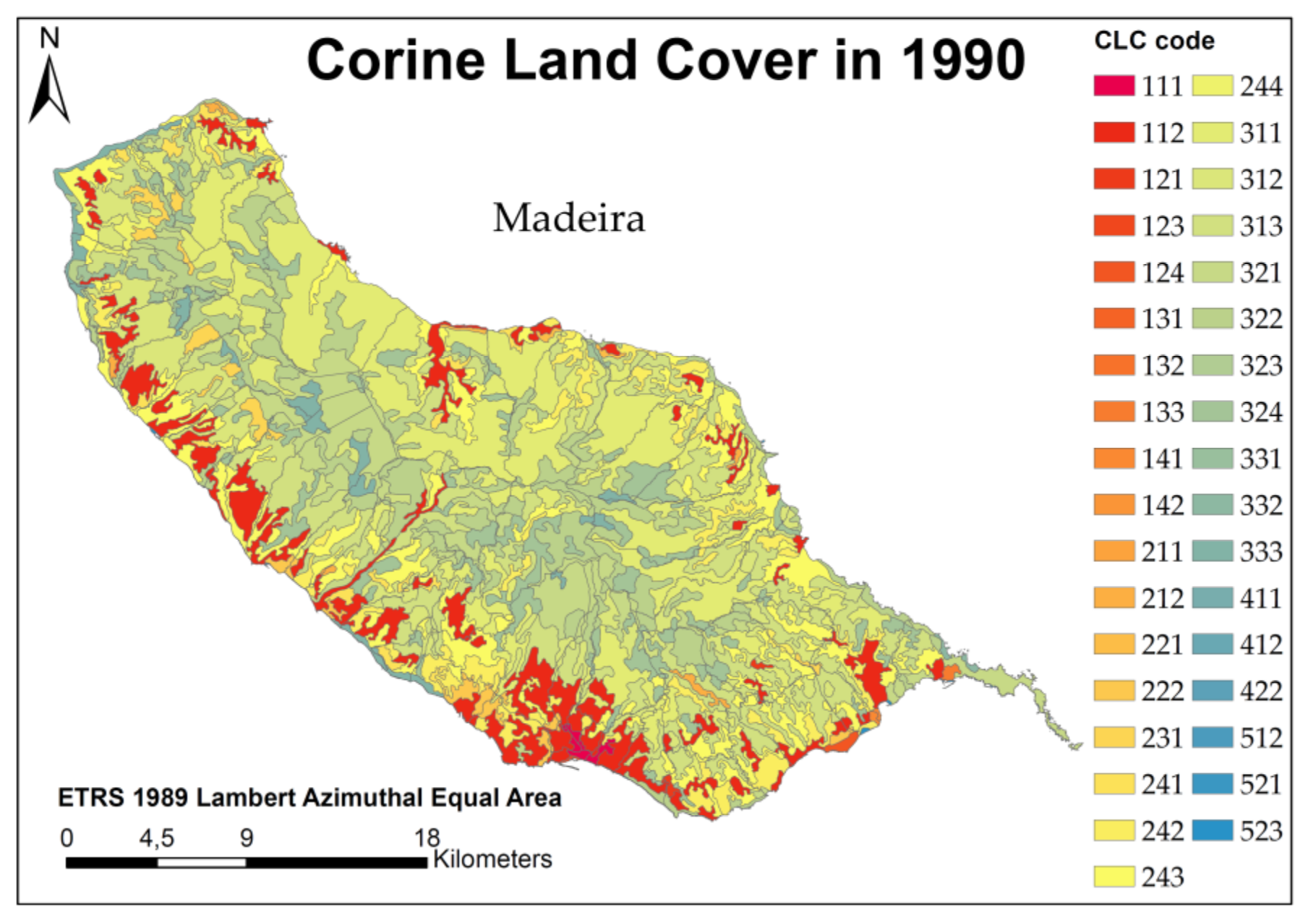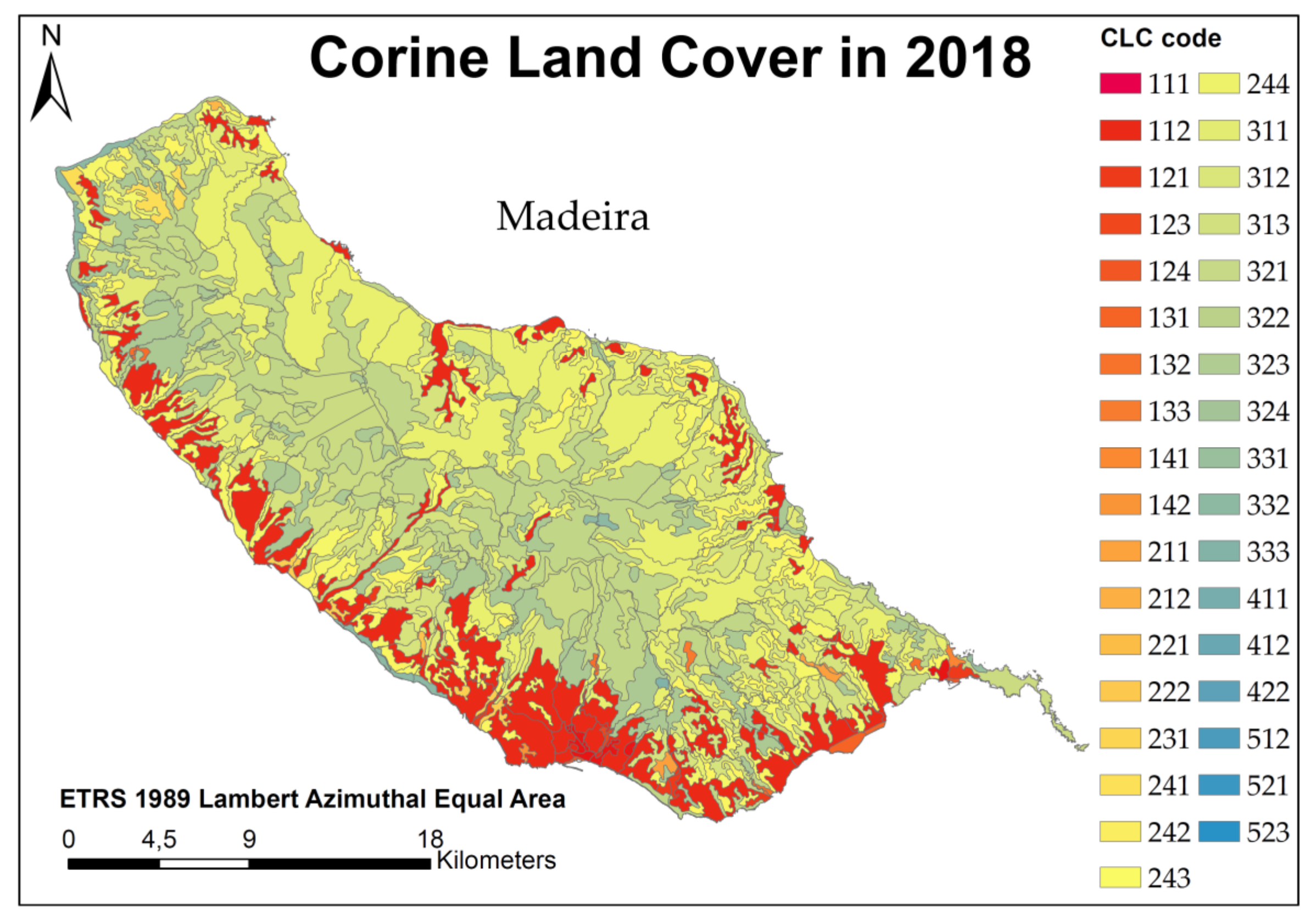1. Introduction
Nowadays, our societies face several challenges. Among these obstacles and requirements, we have regional planning, which is an essential requirement for the so-desired sustainable development [
1,
2,
3,
4,
5,
6,
7,
8,
9]. In fact, such challenges are even more evident in ultra-peripheral territories [
10,
11,
12,
13]. Accordingly, the comprehension of the land occupation dynamics and trends in the ultraperipheral territories is crucial to attempt long-lasting regional sustainability, as is the island region’s case.
In this regard, the European Archipelagos of the Macaronesia Region (the Azores, Canary Islands, and Madeira) were selected as case studies. Consequently, the land-use changes over the last three decades were analyzed. The Azores and Madeira belong to Portugal, whereas the Canaries belong to Spain.
Changes in land-use can be associated with economic growth and investors’ search for profitable locations for the implementation of their projects, supported by local authorities to improve the economic status of local self-government [
4]. This is especially harmful to areas of high environmental quality. Exceptionally high ecological values characterize these islands, so it is necessary and vital to explore the fragmentation of the landscape as monitoring the increase of anthropic pressure, especially in the vicinity of highly urbanized areas.
Fragmentation in landscape patterns can compromise its functional integrity by disrupting critical ecological processes to maintain biodiversity and ecosystem health [
14]. Many anthropogenic activities (e.g., development, logging) can disrupt the structural integrity of the landscape and can sometimes facilitate ecological flows (e.g., animal movement) across the landscape [
15]. Space fragmentation is a phenomenon studied by the scientific community, particularly environmentalists and urban planners (see [
16,
17,
18,
19]). There are numerous works available that refer to the problem of landscape fragmentation [
20,
21,
22]. With increased awareness of environmental sustainability issues and intensifying land development, the importance of the CORINE database and assessment of LULC changes (Land-Use Land Change) are examined [
23,
24,
25].
The Macaronesian region has long been overlooked in comparative LULC research for two reasons. First, compared to other mainland regions more prevalent in academic literature, the small size, and population of the islands denote spatial dynamics of lower magnitude, which may diminish interest in their study. Second, there is a chronic shortage of comparable and uniform geospatial data for this region. Temme and Verburg [
26] recognize a “(...) lack of homogeneous modeling, monitoring, and mapping strategies throughout the EU”.
Up-to-date advances in geographic information technologies (GIS), where applicable FRAGSTATS as a spatial sample analysis program for categorical maps, can present the landscape through a mosaic model of landscape structure. Such a designated landscape is user-defined and can reproduce any spatial phenomenon. FRAGSTATS quantifies spatial heterogeneity and gives the user the ability to form the basis for defining and scaling landscapes in thematic content and resolution.
Contextually, this investigation is based on research techniques. These techniques and methods allow us to identify the dynamics of land-use changes in these territories. The chosen approach relies on proposing new geographical representations and modeling methods that emphasize the importance of geographical visualization of landscape fragmentation for spatial planning in this environmentally critical area. The research provides a greater understanding of the actors and decision-makers involved in how these ultra-peripheral territories have developed and how new territorial plans should be designed.
This work provides novel techniques in evaluating and managing the landscape of the study areas while considering that they could be applied in other research. Besides, the research results can contribute to the sustainable development of the islands.
Therefore, this paper begins with this initial chapter, followed by a brief overview of the literature related to the protection of ecosystem services: a Geographic Information Systems (GIS) and methodology based on CORINE land cover classes (CLC) and FRAG STATS, a methodological framework regarding the techniques used in the empirical part of the research, followed by the results, as well as their subsequent discussion and conclusions, with the final section on the limitations of the study and future research lines.
3. Materials and Methods
The CORINE, Coordination of Information Environment Programme, develops the CLC project, whose main objective is to obtain a European land occupation database for territorial analysis and European policy management. This geographical database, which is the first layer used in the present research, supplies land-uses in the European Union using polygon graphic features.
As for the spatial component, the reference scale is 1:100,000, the Geodesic Reference System is European Reference Terrestrial System 1989 (ETRS89), and the Mapping System is Universal Transverse Mercator (UTM). Additionally, the minimum width recorded for linear phenomena is 100 m. For polygon phenomena, the Minimum Cartographic Unit (MCU) is 25 hectares represented by a square of 5 × 5 mm or a circle with 2.8 mm. Regarding the thematic component, it offers three hierarchical levels of information.
In this regard, the development of ETRS89 is related to the global International Terrestrial Reference System and Frame (ITRS), which describes procedures for creating reference frames suitable for use with measurements on or near the Earth’s surface. Indeed, the continental drift representation in ETRS89 is balanced since continental plates’ total apparent angular momentum is about 0.
Besides, the data is in vector format, using polygons that evoke the various land-uses organized into three hierarchical levels using 44 classes, according to the European Environmental Agency (
Table 1).
The second layer of information used also consists of polygonal graphical features that evoke administrative divisions at their different levels of the three archipelagoes studied: Autonomous Region of the Azores, Autonomous Region of Madeira, and the Autonomous Region of the Canary Islands.
In the Canary Islands, the information was obtained from the Download Center of the National Center for Geographical Information, belonging to the Ministry of Transport, Mobility, and Urban Agenda of Spain’s Government. Specifically, the National Topographic Base was obtained at a 1:100,000 scale [
41].
As for the Portuguese archipelagos corresponding to Azores and Madeira, the information was obtained from the National Geographic Information System, obtaining the Official Administrative Charter of Portugal in 2020 [
42]. The scale is also 1:100,000.
The geodesic reference systems in the archipelago are different. In the Canary Islands, the projection is UTM and zone 27 and 28, being its EPSG (European Petroleum Survey Group) codes 4082 and 4083. So, for the Azores archipelago that also uses UTM projection, the EPSG code is 5015 in zone 26. In the case of the Madeira Archipelago, the EPSG code corresponds to 5016 in zone 28.
In this regard, EuroGeographics, where the Cartographic and Cadastral Agencies of the various European countries are represented, and the Joint Research Centre of the European Commission (EC), decided in December 2000 to entrust CERCO’s No.8 working groups (Commission European des Responsible for Cartographie Officielle (French)) and EUREF (European Reference Frame) transformations with complete development of the technical details of the conventional Coordinate Reference System for Europe, to be adopted by the EC. Accordingly, recommendations to the European Commission [
43] turned out to be: (1) Adopt ETRS89 as a geodetic datum and (2) Host, for statistical analysis and presentations, the ETRS89-Azimuth Equiarea coordinate system of Lambert-2001 (ETRS-LAEA) [
44]. The ETRS-LAEA is based on the projection of equivalent areas in the territory. In this way, it serves as a reference for homogeneous units for all European countries. As a result, this coordinate system is used for the representation of analytical and statistical data.
In fact, this work intends to compare the area obtained from the uses of CLC in 1990, 2000, 2006, 2012, and 2018 in the archipelagoes of the Canary Islands, Azores, and Madeira. As a result, from Feature Manipulation Engine 2020.2 (FME) software developed by the company SAFE software, all layers of information were transformed to ETRS89-LAEA.
Subsequently, all layers were managed using ArcGIS 10.5 software. Initially, in the administrative divisions’ representative layers, the islands corresponding to the archipelagoes to be studied were selected. Three layers of information were obtained, one layer for each archipelago. These layers were then merged into a single layer. This was possible because all layers used the same graphical rendering features, that is, polygons. Thus, a single layer was obtained with the delimitation of the work area. Then, geoprocessing the previous layer corresponding to the islands’ administrative delimitations and the CLC layer corresponding to 1990 were related, using the clip tool. In this case, two layers are related to polygonal graphic features. Moreover, a resulting layer with polygons containing the land-use CLC in 1990 included in the various administrative divisions of the islands, including the islands and municipalities was obtained. The associated alpha-numeric information has three fundamental fields: (1) the CLC code of each polygon, (2) the island on which the CLC land-use representative polygon is located, and (3) the municipality where each registered land-use is located. However, there was no field corresponding to the surface occupied by each of the polygons representative of the CLC land-uses within each administrative division. Thus, a geometric measurement on the ETRS89-LAEA projection in hectares of each of the various polygons representing land-uses within each municipality analyzed was carried out. To this aim, a new field of information was generated, and with this, the area was geometrically calculated in hectares.
This procedure linking the islands’ administrative divisions and land-uses for 1990 was also repeated for 2000, 2006, 2012, and 2018. In this way, a table of information was obtained for each of the years analyzed. The alphanumeric information obtained for each previous year was then exported and integrated into a Microsoft Access-managed database belonging to the Microsoft Office 365 package.
Moreover, a query was made using a structured query language (SQL) to select land-uses for each of the islands in 1990. Then, the previous query was queried by CLC codes of the registered hectares, also using SQL. So, a table was obtained with the CLC land-uses and the corresponding hectares on each of the islands for 1990, 2000, 2006, 2012, and 2018. Then, to compare the area obtained on each of the islands and archipelagos, it was necessary to normalize the data. Thus, the percentage occupied by each of the land-uses classified according to the CLC code was calculated relative to the total area of the corresponding archipelago for the first and third CLC level.
The calculation of landscape fragmentation analysis was then performed. For this purpose, CLC land-uses were used for the archipelagoes studied in 1990 and 2018. First, for each of the three archipelagoes considered, ArcGIS 10.5 software transformed the polygon vector layer representative of CLC land-uses to a raster file in TIF format with 30 m of cell size, using the CLC level 3 naming value for the output raster file. Subsequently, the TIFF file (.tif) was exported to an ERDAS Imagine grid (.img) file. Then, reviewing the alphanumeric information associated with the latter raster file, a text file was generated with the class descriptors.
Once all this information was prepared, the FRAGSTATS 4.2 software was used to perform patch metrics, class metrics, and landscape metrics using the eight-cell neighborhood rule.
In this regard, the calculations are applied to each fragment individually, to each polygon representing a land-use according to level 3 of the CLC. In this way, indexes obtained with these metrics can be interpreted as fragmentation indexes because they measure the configuration of a particular patch type.
In our case, aggregation measures such as Euclidean Nearest-Neighbor Distance (ENN) equals the distance (m) to the nearest-neighboring patch of the same type. where . is the distance (m) from patch to nearest-neighboring patch of the same type (class), based on patch edge-to-edge distance, computed from cell center to cell center.
In addition to the standard patch metrics, FRAGSTATS 4.2 computes several deviation statistics for each patch that measures how much it deviates from the class or landscape norm. For this reason, through the before metric which was obtained by the standard deviations from the landscape mean (LSD): the value of the metric (
x) for the focal patch (
ij) minus the mean of the metric across all patches in the landscape divided by the landscape standard deviation:
where:
= value of a patch metric for patch ij.
= mean value of the corresponding patch metric across all patches in the landscape.
= standard deviation of the corresponding patch metric for all patches in the landscape.
Specifically, the distance between the different patches can be valuable information, based on the basis that greater isolation implies a reduction in the chances of harboring or maintaining a greater degree of biological diversity [
44,
45,
46]. On the one hand, it provides information about the feasibility for species to survive and travel between the different elements to preserve their ecological value. On the contrary, it can also help eradicate species that have generated a pest. For this reason, corridors that allow the connection between patches play a fundamental role and reduce the distance effect that determines the presence of fewer species in isolated fragments [
47].
As for class metrics, the calculations apply to each set of fragments of the same class, that is, those with the same value or that represent the same type of land-use, in our case. It is the appropriate level for calculating which area occupies a specific soil cover, such as forests, or the average extent occupied by forest fragments.
In this case, shape metrics were performed as the arithmetic mean of the shape index equals patch perimeter (given in the number of cell surfaces) divided by the minimum perimeter (given in the number of cell surfaces) possible for a maximally compact patch (in a square raster format) of the corresponding patch area.
where:
If
aij is the area of patch
ij (in terms of number of cells) and
n is the side of a largest integer square smaller than
aij, and
m =
aij −
n2, then the minimum perimeter of patch
ij,
min-pii will take one of the three forms [
48,
49]:
when m = 0, or
when , or
when .
In addition, the calculation of the arithmetic mean of the fractal dimension index was executed that calculates the degree of complexity of each fragment from the relationship between area and perimeter:
where:
The shape of fragments is of paramount importance and is sometimes even considered more relevant than dimension. The form is conditioned by human activity and natural conditions such as topography. Thus, the mastery of natural conditions favors curvilinear and irregular forms. On the contrary, the mastery of human activity promotes the diversification of forms. Intense human activity implies a simplification of variability [
50].
Finally, the number of patches was calculated—the number of total fragments and the number of fragments of each class since the number of tiles is the most straightforward metric that can explain the extent to which land-use is divided or fragmented.
Concerning land metrics, calculations apply to the landscape as a whole, that is, to all fragments and classes at once. The result informs us of the degree of heterogeneity or homogeneity of the whole area quantified. In our case, two diversity measures were carried out. Firstly, the Shannon’s Diversity Index (SHDI) values landscape diversity, i.e., heterogeneity, based on fragment diversity. Its absolute value is not very significant, but it helps to compare different landscapes or the same landscape at different events of time:
where
= proportion of the landscape occupied by patch type (class)
i.
SHDI equals, minus the sum, across all patch types, of the proportional abundance of each patch type multiplied by that proportion. Note, is based on total landscape area (A) excluding any internal background present.
Secondly, the Shannon’s Everness Index (SHEI) was calculated which is a reverse index of the previous one, both at the calculation and interpretation level, based on landscape homogeneity:
where:
= proportion of the landscape occupied by patch type (class) i.
= number of patch types (classes) present in the landscape, excluding the landscape border if present.
In this case, the SHEI will be applied to assess uniformity in land-uses in each of the archipelagoes.
3.1. The Macaronesia Region
The three archipelagos (
Figure 1,
Figure 2 and
Figure 3) share regional features: a volcanic origin, a contrasting landscape, and a gentle climate. These features have created an ideal environment for vibrant biodiversity [
51]. The name Macaronesia is derived from the Greek words meaning "islands of the fortunate." Ancient Greek geographers first used the name to refer to any islands west of the Strait of Gibraltar. Macaronesia is a collection of four volcanic archipelagos in the North Atlantic Ocean, off Europe and Africa. Each archipelago is made up of several Atlantic oceanic islands formed by seamounts on the ocean floor and have peaks above the ocean’s surface.
Some of the Macaronesian islands belong to Portugal, some belong to Spain, and the rest belong to Cape Verde. Geologically, Macaronesia is part of the African tectonic plate. Some of its islands—the Azores—are situated along the edge of that plate when it abuts the Eurasian and North American plates. According to the European Environment Agency, the three European archipelagos constitute a unique biogeographic realm known as the Macaronesian Region (
Figure 4). Entirely volcanic, the Macaronesian islands share a gentle climate and offer a wide variety of landscapes. The large calderas, jagged mountains and cliffs, broad valleys, and sheltered bays are home to various species and habitats. The islands may represent a mere 0.3% of the EU territory, but they host 19% of the habitat types and 28% of all the plants listed in the
Habitats Directive [
51].
Macaronesian islands are volcanic in origin and are thought to be the product of several geologic hotspots. The Macaronesian islands represent a wide range of climates. The annual average maximum temperatures in the Canary Islands range from 24 °C in coastal areas to values below 10 °C in the Pico de Teide. The annual average maximum air temperature in the Azores and Madeira is between 12 °C and 14 °C in higher altitudes and below 8 °C in Ponta do Pico on Pico Island in the Azores. The highest maximum air temperature values in the Azores, above 20 °C, occur in some coastal areas of São Miguel, Santa Maria, Terceira, Graciosa, and Pico. In Madeira, the highest average maximum air temperature values are also above 20 °C in coastal regions of Madeira and in almost the entire island of Porto Santo, where values are even higher than 22 °C in the southern and north-western coastal strip of the island of Madeira [
53,
54,
55,
56,
57,
58].
There are maritime temperate, the Mediterranean, and subtropical climates in the Azores and Madeira; the Mediterranean and subtropical climates in some of the Canary Islands; arid climates in certain geologically older islands of the Canaries (notably Lanzarote and Fuerteventura) and some of the islands of the Madeira Archipelago (Selvagens and Porto Santo) and Cape Verde (Sal, Boa Vista, and Maio); and a tropical climate in the younger islands of both of the southernmost archipelagos (Santo Antão, Santiago, and Fogo in Cape Verde). In some locations, there are variations in climate due to the rain shadow effect. Macaronesia’s laurisilva forests are a type of mountain cloud forest [
51] with relict plant species of a vegetation type that originally covered much of the Mediterranean Basin when the climate of that region was more humid. Many of these plant species are endemic and have evolved to adapt to the islands’ variable climatic conditions. For example, the Laurisilva of Madeira is the largest surviving relict of a virtually extinct laurel forest type, once widespread in Europe. It is still 90% primary forest and is a center of plant diversity, containing a unique suite of rare and relict plants and animals, especially endemic bryophytes, ferns, vascular plants, and animals, the Madeiran long-toed pigeon, and a vibrant invertebrate fauna [
59,
60].
Much of the original native vegetation has been displaced because of human activity, including felling forests for timber and firewood, clearing vegetation for grazing and agriculture, and introducing foreign plants and animals into the islands. The laurisilva habitat has been reduced to small disconnected pockets. As a result, many of the endemic biotas of the islands are now seriously endangered or extinct.
Since 2001, the European Union’s conservation efforts, mandated by its Natura 2000 regulations [
51], have protected large stretches of land and sea in the Azores, Madeira, and the Canary Islands, totaling 5000 km
2.
All archipelagos are outermost regions that are far from the countries or continent to which they belong, which requires special treatment to achieve the connection and development of these territories’ economies.
The European Archipelagos of Macaronesia Region
Azores
The Azores are an archipelago formed by nine islands, which constitute an autonomous region of Portugal. Its official language is Portuguese, and it has approximately 250,000 inhabitants in its 2.333 square kilometers of land. The largest island is São Miguel, where more than half of the Azores archipelago population is gathered, whose main city is Ponta Delgada.
The Azorean climate, relief, and rich soils are particularly suitable for agriculture, and the islands are now heavily deforested: only 2% of the original laurel forests remain [
40]. The endemic Azores bullfinch (
Pyrrhula murina) was once a common feature of the native forests and saw its population plummet to 120 pairs. However, it is now on the road to recovery thanks to an EU LIFE project that has now caused the population to treble [
51].
Madeira
It is an archipelago that is part of Portugal, formed by only two inhabited islands, Madeira and Porto Santo, with more than 260,000 inhabitants in an extension of 828 square kilometers. Three smaller islands that are not inhabited are also part of the archipelago.
Agriculture is the mainstay of Madeira’s economy but has remained mainly small-scale due to the rugged landscape. Tourism is becoming increasingly important, generating 10% of the island’s GDP and employing a significant proportion of the 250,000 islanders [
51].
Canary Islands
The Canary Islands are formed by seven islands, subdivided into two provinces, being one of Spain’s autonomous communities. On the archipelago’s whole lives approximately 2,200,000 people in an extension of 7500 square kilometers, the most populated island being that of Gran Canaria, followed by Tenerife.
Tourism is the most important economic activity. Mixed and terraced farming is still practiced inland but has rapidly disappeared, replaced by the tropical and forced crops for the export market, accounting for 75% of the agricultural end production; 18,000 ha of highly fragmented laurel forest remain. Only 6000 ha correspond to mature forest [
51].
5. Discussion and Conclusions
5.1. Azores Archipelago
Land-use shows similar patterns in all the Azores’ islands, emphasizing the installation of urban areas next to coastal regions. In fact, some of the obtained results could be explained by the specific geomorphology of each island.
Nevertheless, the predominance of areas related to agricultural and pasture activities, and forests and natural environments between these areas and the islands’ interior is evident.
The territorial areas in which the forest and natural vegetation have greater representativeness are those where there is a protection status, attributed under the Regional Network of Protected Areas or the Natura 2000 Network, contributing to the conservation of biodiversity, strengthening the claim of Azores as a nature destination. Here, the Western Group islands assume a considerable weight, and São Jorge and Pico, with the surface’s occupations by agricultural areas as natural pastures and landscapes, and the forest and natural vegetation of around 60%. The lagoons, usually constituting points of relevant interest for tourist activity, are only represented on three islands: Corvo, São Miguel, and Flores. However, except Graciosa alone, all other islands have inland water bodies of appreciable beauty.
There is a significant increase in urban areas in evolutionary terms, reflecting the urban growth that has been witnessed in recent years. The agricultural and pasture areas have decreased in recent years, considering that in the 1990s, they represented more than 50% of the Azores area. On the other hand, there was an increase in forest areas and natural environments, when in the middle of the 1990s, they represented nearly 30% of the Azores’ territory.
Regarding the artificial occupation of the territory—the urban occupation—about 3.4% of the surface of the territory of the Azores is characterized mainly by discontinuous urban fabric, representing 67% of the total urban fabric of the Azores. Only in the largest island—São Miguel—the continuous urban fabric is predominant, with around 59%. Industry, commerce, general equipment, and infrastructure only represent 0.44% of the Azores’ surface total occupation. The islands with the greatest relative implantation of this economic activity are São Miguel and Terceira—the Azorean economy engines.
5.2. Madeira Archipelago
Identifying the different land-uses in the years analyzed in the Madeira archipelago allows for differentiating these land-uses according to their extension, determining which are the most extensive land-uses, and therefore, more hegemonic. Under this criterion, the forest and semi-natural areas constitute the predominant land-use, since it occupies, in all the years analyzed, approximately 70% of the surface of the archipelago, increasing progressively even in all the last years analyzed.
The second most predominant land-use alternates throughout the analyzed years. Between 1990 and 2000 corresponds to agricultural areas. However, between 2006 and 2018, artificial surfaces were the second most predominant land-use, always with percentages of approximately 15%.
In this regard, both agricultural and artificial surfaces between 2012 and 2018 show a downward trend. Likewise, these land-uses are directly related to human activity. Therefore, it could be said that the incidence of humans in the archipelago is becoming less and less impactful in terms of land-uses.
The presence in the archipelago of the remaining land-uses is practically non-existent. Regarding the water bodies, they occupy an area consistently below 1.5%. Besides, they tend to shrink as the years go by. As for the latest use of wetlands, soil practically does not exist. However, both water bodies and wetlands, due to their importance, predominantly environmental, must be monitored in order not to reduce their presence, and thus disappear in years to come.
Regarding the location of the different land-uses on the islands that make up the archipelago, Desert Islands always have the same land-uses; as the name suggests, they are deserted, and the lack of human activity makes the variation in land-use virtually non-existent. The same is not valid on the other islands where other patterns are observed. Thus, on the island of Porto Santo, the artificial surfaces are concentrated in the central region. Besides, these land-uses are usually surrounded by agricultural areas, and forest and semi-natural areas. In this regard, the accumulation of artificial surfaces in the same region could indicate that they are under tourist pressure. As for Madeira’s island, the pattern of location of land-uses is reversed, as artificial surfaces are grouped into outlying coastal areas, mainly in the south and also in the north but to a lesser extent. Additionally, the central part is dominated by land-uses unrelated to human activity. Therefore, this area registers less anthropic pressure.
5.3. Canary Archipelago
The predominant land-use corresponds to forests and semi-natural areas, as it occupies approximately three-quarters of the territory. Therefore, this land-use should be used to conserve existing ecosystems in the archipelago. However, over the last three years analyzed (2006, 2012, and 2016), a slight downward trend could continue over the years. However, there is little chance that it will lose its hegemony in the territory analyzed. The second predominant land-use corresponds to agricultural areas, occupying approximately one-fifth of the territory. The third majority use refers to artificial surfaces, occupying approximately 6% of the area analyzed. These last two land-uses are directly related to human activity on the territory, taking into account that their surface area increases slightly over the years analyzed; so, it can be said that the most impactful activity of the human being on the territory analyzed is also increasing slightly. As a result, all activities related to these two land-uses should be monitored. Moreover, water bodies’ existence is residual, and curiously, there are no significant records for wetlands.
As for the location of the various land-uses, more significant variation is observed in areas located on some islands’ peripheries, where there is an increase of artificial surfaces. Among all the islands stand out Tenerife and Gran Canaria, as they are the most populated areas and there is a more intense tourist activity. There is also less anthropic pressure in the internal regions. Therefore, these regions are less exploited by both population pressure and the tourism industry. In fact, in these areas, the use of forests and semi-natural areas predominate, and are spaces that should serve to preserve the eco-systems of the archipelago.
If we analyze this territory more closely and from different perspectives, it is possible to understand the considerable impact of tourism over all the regional economy. In 2017, economic activity represented 85.7% in services (related to tourism), 7.6% in industry and energy, 5.4% in construction, 3.7% in the manufacturing industry, and 1.3% in agriculture and animal breeding and fishing. In the Canary Archipelago, tourism activity obtains a meaningful relevance in numerous contexts due to its economic potential.
In the Canary Archipelago, tourism is a cultural event in which people move freely for a certain period for various reasons, i.e., recreation, rest, culture, or health [
53]. According to Santana [
54]: “(...) tourism is a complex and dynamic activity in close relationship with society and its nuances—behavior, motivations, values, history, traditions, and beliefs.” In fact, the Canary territory is a tourist destination in the reorientation phase [
55]. Contextually, the Canary Islands’ Government is committed to “the renewal, innovation and regeneration” of the tourist area, always having northern tourism of higher quality [
56]. Additionally, tourism planning inevitably includes planning both in terms of tourism and spatial planning [
37]. Therefore, it is common to have land-use policies, namely legislation on the territory’s division into fields varying from environmental protection categories to control tourism development spaces [
57]. Nonetheless, spatial planning usually results in the “post” when several destinations are previously openly overloaded or threatened [
58].
5.4. General Conclusions
The remote islands face many challenges today as land-use changed from 1990 to 2018, along with the increase in the number of visitors, when the demand for living space increased and the resource capacities were limited. As we have seen, it has not been possible to maintain the islands’ situation as it was before, and change will continue to be made. What is essential is that the living environment and the island areas’ unique character should be preserved and protected; the priorities must be defined, and management strategies established which are significant for the well-being of these highly valued areas. Forestry, as the traditional land-use and predominant land-use in island areas, especially in Madeira Archipelago and Canary Islands (over the last three years analyzed (2006, 2012, and 2016), a slight downward trend) should support sustainable forestry as an appropriate form of land-use. With responsible management, the natural resources of island areas can be used for a long time [
61,
62,
63,
64,
65]. Degradation of water quantity and quality cannot be overlooked, particularly on some small islands where groundwater conditions have completely changed. It is possible to identify a notable increase in the artificial surfaces (Code 1) in the Azores and Canary islands during the study period. In addition to recognizing that agricultural land is traditional, and agriculture is a valuable activity, it is necessary to encourage agricultural management practices that are compatible with the sustainable development of islands area [
65,
66,
67,
68]. As examples of these practices, it is possible to name some as: use of renewable energy sources; integrated pest management; hydroponics and aquaponics; crop rotation; polyculture farming; permaculture; avoiding soil erosion; crop diversity; among several others. According to ESPON Program for the Develpment of the Islands [
68]: “Due to the relatively small land masses and isolation, islands are typically land-resource constrained. This limits living space, space for infrastructure, waste disposal, agricultural production, industrial development, water resource availability, among several others. Additionally, it results in very vulnerable ecosystems with high endemism.” Thus, pressures resulting from anthropogenic factors can have more critical consequences on insular environments, invaliding their capability to supply goods and services, and sustain life.
Detailed analysis metrics have been presented throughout this work as a helpful instrument in the analysis, monitoring, and monitoring of changes in land-uses, through different levels of analysis until their application as a comparison tool in different temporal situations.
In this sense, patch analysis shows that there is greater fragmentation in each of the regions analyzed. In addition, the class analysis makes it possible to establish that there has been no increase in land-uses in the Azores Autonomous Region. On the contrary, in the Autonomous Region of Madeira and the Autonomous Community of the Canary Islands, diversity in land-uses was increased. It could therefore be said that in the latter two regions, anthropic activity has been greater. More compact shapes are generally observed in the latter two regions. In addition, landscape metrics make it possible to state that the Madeira Autonomous Region, despite being the smallest in the extension of the areas analyzed, is the one with the greatest diversity, although in decline in the years analyzed. On the contrary, there is less diversity in the Autonomous Community of the Canary Islands despite being the most extensively analyzed region.
5.5. Study Limitations and Prospective Research Lines
The limitations of this study are directly related to the technical limitations of CLC. In this regard, if we consider the three analysis components that we can deal with a GIS, it is possible to describe each of them.
As for the spatial component, the geometric accuracy has been going down over the years, analyzed from 50 m to be below 10 m. While it has improved considerably, this could have been slightly better in the years leading up to 2018, and it would be optimal for it to be improved over the years to come. Moreover, while it is true that the minimum mapping unit and minimum mapping width have always been the same over the years, 25 hectares and 100 m respectively, it would have been optimal to have lower minimum mapping units. However, the minimum mapping unit is considered appropriate for the extent of the analyzed terrain and the scale of data processing geometric accuracy. Regarding the thematic component, the accuracy in identifying the various land-uses has always been equal to or greater than 85%. Therefore, although there is a slight range of improvement, this accuracy has always been high.
Concerning the landscape metrics recorded, a more specific analysis focused on more specific objectives would be desirable to determine the evolution of some of the land-uses analyzed.
Finally, concerning the temporary component, the last update to land-uses occurred in 2018. It would therefore be optimal if there were more up-to-date land-use data. Besides, note that the products offered by CLC are of high quality and rigorous. Furthermore, these products are open and cover a large area of territory.
